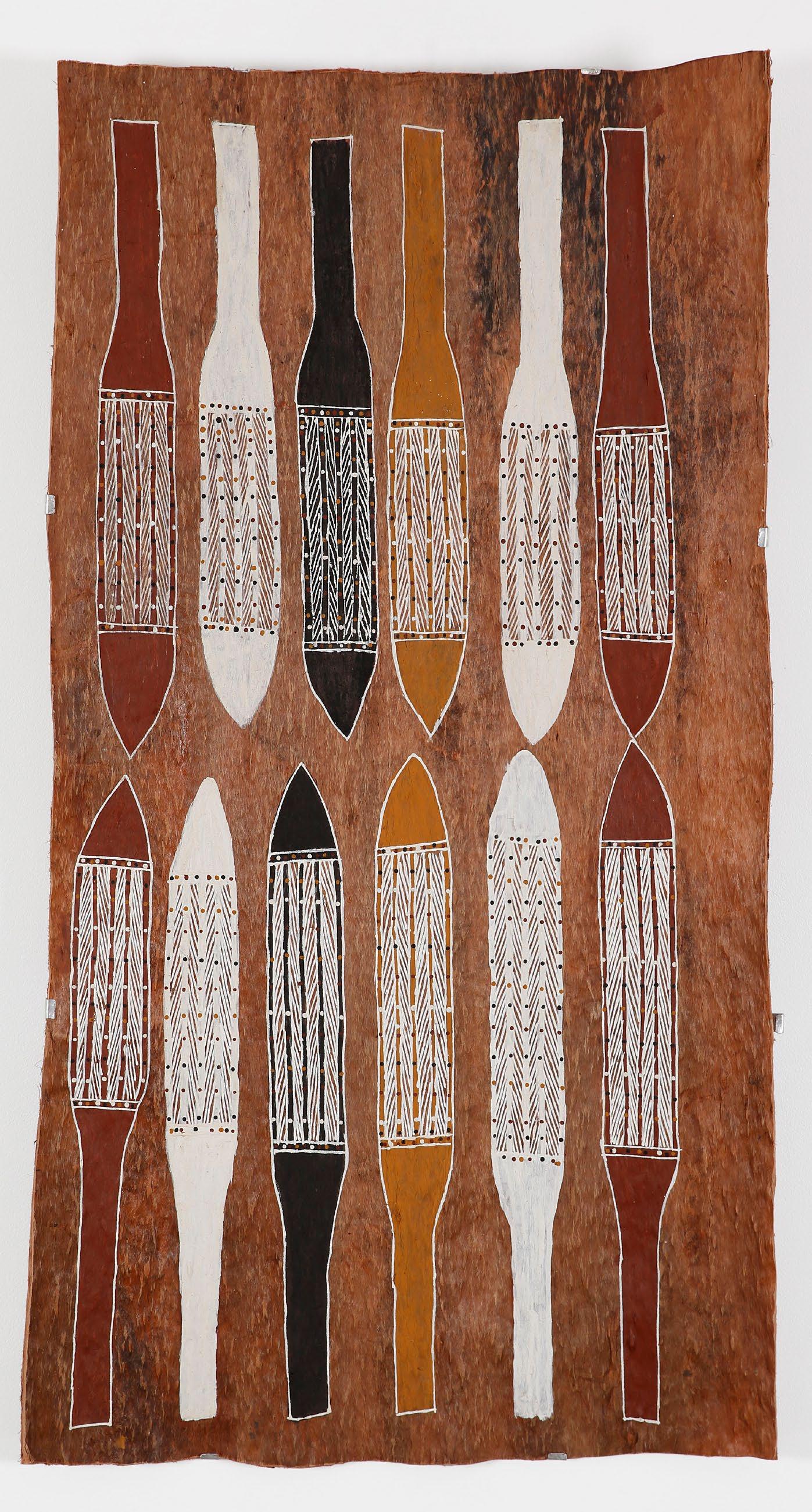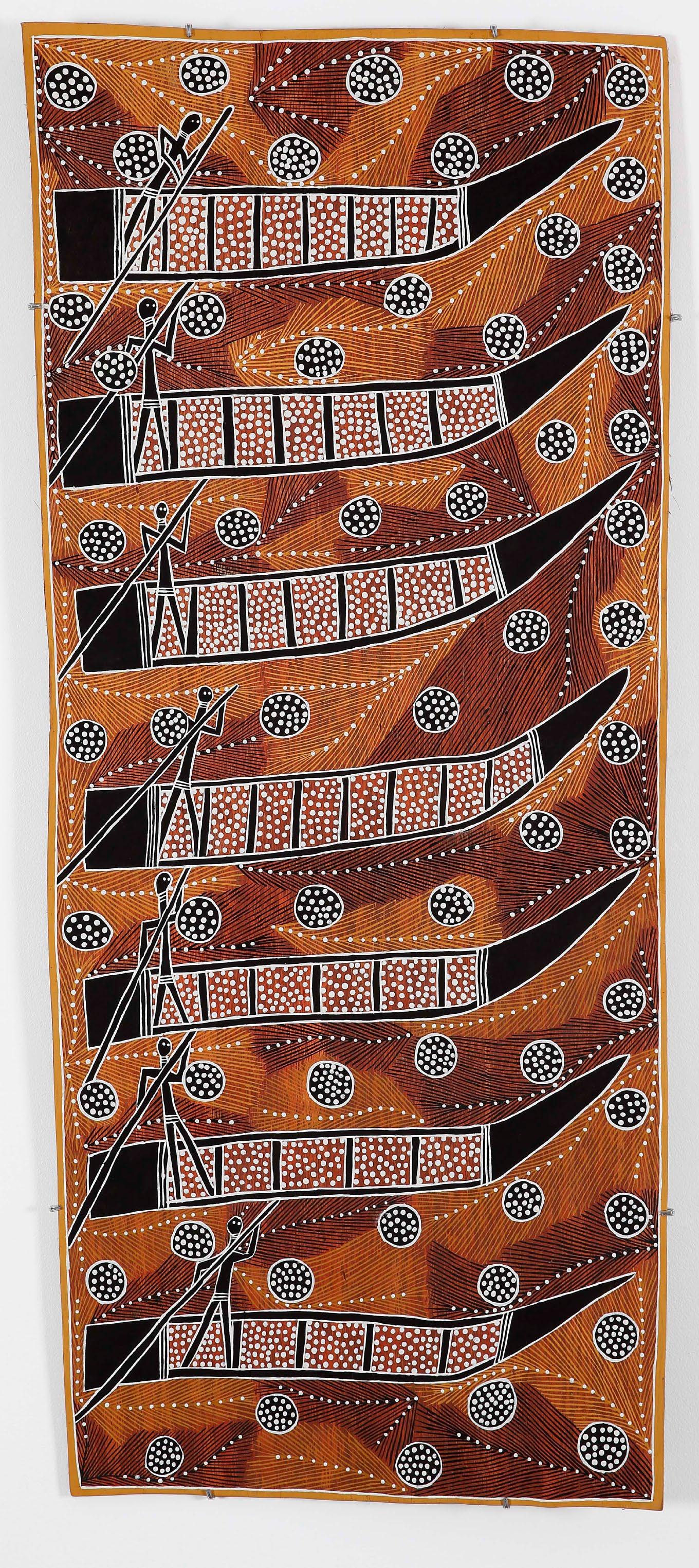Ŋupan Ringitjmala | Following Songlines



8 - 26 July, 2025
Presented by Aboriginal & Pacific Art in association with Milingimbi Art and Culture, Arnhem Land NT.


(The Story of Warrabunbun)
#137-24
Ochre on wood
120 x 62 cm


This large-scale work shows the Gupauyŋu Daygurrgurr clan Burala, a ceremonial object that represents the wing of the diving bird (Comorant). Burala is an important element of the Gupapuyŋu mortuary rights ceremony called Djalambu, which also refers to the funeral pole in which the remains of the deceased are interned. The artist was inspired to make this painting while researching early historic collections taken from Milingimbi, especially from the period between 1920’s to the 1950’s. During this research the artist came across Burala objects made by members of his family, including his father, acclaimed painter and ceremonial leader Tom Djäwa.
Joe Dhamanydji
Burala - Gupapuyŋu djalambu dhäwu (Gupapuyŋu funeral pole story) #272-23
Ochre on bark
75 x 145 cm

This work shows the Gupapuyŋu Daygurrgurr clan design Guku (Native Bee and Honey) in the full splendour of its ceremonial expression. The artist, inspired by researching historic collections from the 1920’s, has referenced the ceremonial dillybags, spears and orthodox galaŋarr style bark paintings made by his forefathers and found in these early collections.
Galaŋarr is a Yirritja word used by dhuwala-mirri language speakers to indicate the form used when painted on bodies during ceremony. This includes the main rumbal (body) painted on the chest, yaŋara’ (legs), and wana (arms) that are painted over the shoulders. During the high law ceremony of ŋärra, these layers of design are added progressively throughout the ceremony to make the final complete form, which is seen in this painting.
Joe Dhamanydji
Guku Galaŋarr (Gupapuyŋu Body Paint)
#289-23
Ochre on bark
148 x 46 cm

This large-scale work shows the Gupauyŋu Daygurrgurr clan burala, a ceremonial object that represents the wing of the diving bird (comorant). Burala is an important component in Gupapuyŋu mortuary rights that takes its name from djalambu, the funeral pole in which the remains of the deceased are interned.
Burala are carved elpictical objects attached to twinned bush string made from balgurr’, the inner bark of the Kurrajong tree. The burala is spun at high speed, creating a jet-like, eerie whirring noise during the djalambu ceremony. This noise is said to immitate the noise of the burala bird when diving towards the ocean at high speed while hunting it’s prey, often juvenile manburi, or catfish.
Joe Dhamanydji
Burala - Gupapuyŋu djalambu dhäwu (Gupapuyŋu funeral pole story) #282-24
Ochre on bark 137 x 47 cm

This is Garraŋunuŋ, the Hammerhead Shark. Garraŋunuŋ is from Luŋgutja, an island belonging to the Gupapuyŋu Birrkili clan in Arnhem Bay. The artist’s older brother, senior Gupapauyŋu ceremonial leader George Milaypuma explains:
Garraŋunuŋ, he’s a quiet one. Not like other big sharks, or stingrays or barracuda. They got sharp teeth and barbs. They’re little bit danger one, madakarritj (angry and aggressive).
Garraŋunuŋ just has a big nose and small teeth. But his manikay (ceremonial song cycle) says that he’s madakarritj. So maybe he is danger one... So you better be careful!
The manikay song cycle is shared with neighbouring clan Gupapuyŋu Daygurrgurr and describes how the hammerhead uses his large nose to hunt and fight, referencing certain species of fish and stingray which it favours. This painting was made in response to a similar work made by the artists father, esteemed ceremonial leader Tom Djäwa.
Joe Dhamanydji
Garraŋunuŋ (Hammerhead Shark) #161-24
Ochre on bark 170 x 63 cm

This dhuwa painting is divided into two halves that relate to each other as märi (mother’s mother) and gutharra (a woman’s daughter’s daughter), which reflects the relationship between the two miny’tji (clan designs) represented. Gamalaŋga the grandmother clan can be seen on the left, and Malarra, the granddaughter clan can be seen on the right side. Both clans are associated with Murruŋga, an island northeast of Milingimbi.
David Yarrang Roy
Gurrmirriŋu ga Larratjatja - Mällarra ga Gamalanga - David Roy #37-25
Ochre on bark
130 x 72 cm

Joe Dhamanydji’s work, titled ‘Yothu Yindi - Dhukurruru, Warraga’ ga Burarr Gapu (Mother and Child - Travelling Rock, Cycad Nuts and Sacred Springs)’ shows the meeting of his mother and maternal grandmother, who in turn sit in a reciprocal mother and child relationship. The painting shows the sacred waters released by the powerful Dhuwa moiety Djan’kawu ancestors (top panel) flow and mix with their mother waters (main and bottom panel), the Yirritja moiety Mandjikay waters associated with the Dhukururru, a sacred rock that travels from the inland escarpment country to the saltwater coast.
Joe Dhamanydji
Dhukururru, Warraga’ ga Burarr Gapu (Sacred Rock, Cycad Nut and Freshwater Springs) #71-24
Ochre on bark 138 x 49 cm

“I remember when I was a young boy with my märi-mu (Paternal Grandfather). We go out looking for goose eggs, crocodile eggs, long-neck turtles, duck eggs and water snakes - too many! We used those naku, the bark canoe. My märi-mu would make them. Cut the bark and burn him to make the shape, sew it up at the front and back. Then we could get all that food. Too clever my märi-mu.”
- Matthew Djipurrtjun
Matthew Djipurrtjun
Naku Muwangi - A History Story #158-24
Ochre on wood
150 x 65 cm

This large-scale work shows Guku (Native Bee and Honey), the iconic Gupapuyŋu Daygurrgurr clan design and its ceremonial manifestation as a ritual object used in the Gupapuyŋu ŋärra high law ceremony. The object and its diamond-shaped painted design refers to the ancestral journeys of the Guku Honeybee.
In part, the central element of the painting represents the dhudi dharpa’, or foundational knowledge held in Gupapuyŋu law (lit. ‘the stump/root of the tree’). The intricate rärrk crosshatching shows the rich flowing honey inside the tree where these bees hive, which is said to be akin to the spiritual force that animates Gupapuyŋu land and people. This element of Guku is often considered the highest form of its material expression and as such, a pure expression of Gupapuyŋu knowledge and thought.
Joe Dhamanydji
Guku Ŋänitj Djiliwirriw (Honey of Djiliwirri)
#271-23
Ochre on bark
67 x 158 cm
119



This yirritja painting is about birrkuda (literally meaning cheeky bee), said to be the diamond shaped miny’tji (clan design) that is the primary Gupapuyŋu Daygurrgurr and guku, referring to both honey and the bees that produce it. The work also portrays another yirritja relative, the nyaŋura (long-neck turtle).
The artists’ brother George Milaypuma explained that in this work there is “honey everywhere”. In the centre of the design, you can see the hive of the honeybee filled with guku in its iconic diamond-shaped pattern, with some areas appearing as full of flowing honey represented by rarrk (crosshatching), and some appearing empty. Milaypuma says “it’s not empty [the hive], but it’s got a little bit [of honey]”. The striped panels at the base of the painting also depict guku, the artists Joe Dhamanydji ex-
Joe Dhamanydji
Guku ga Nyaŋura (Honey and Long-neck Turtle)
#222-24
Ochre on bark 92 x 60 cm

This is a Yirritja painting belonging to Yathalamara, just north of Ramingining. At the top of the painting, you can see the two freshwater holes found there, Yathalamara and Bilimarr, that are linked by sand. The two black circles show the water, and the sand that links them is shown with rärrk (crosshatching).
In the centre is a burala (Darter bird), which, despite being shared with many bäpurra (clans) and wäŋa (places), comes from Yathalamara. He is shown sitting on a trunk floating in the waterhole, looking for fish. The artist Milaypuma explains how he has painted burala the way his father Tom Djäwa did, the way Gupapuyŋu people do.
George Milaypuma
Burala at Yathalamara #219-24
Ochre on bark
54 x 40 cm

This painting depicts the freshwaters of Ŋaliyindi billabong near Muwaŋgi, the Arafura Swamp, on Ganalbiŋu country near Ramingining. There you can find nyaŋura (long-necked turtle), nyuŋala’ (oxe-eye herring), ŋaw’ŋaw (waterlilies) and the much-coveted gurrumattji (magpie goose). Floating amongst all this life are djalŋiny (leeches) and wokara (sedge grass). Sometimes this design includes small dots known as maditj, the seeds of the waterlily which are eaten by gurrumattji and found in the waters of the swamp.
Ganalbiŋu Yolŋu are renowned gurrumattji hunters in Arnhem Land and have developed a whole range of specialised technology and techniques to catch their prized prey. This includes the long-nosed ŋadan canoe, designed to separate the thick sedge-grasses that fill the Arafura swamp and made famous in the film 10 Canoes. Hunters also make unique treetop hunting huts that are used on the long water-bound hunting trips during the flooded months of the wet-season.
Matthew Djipurrtjun
Gurrumattji Ŋaliyindi’ŋur (Magpie Geese at Ŋalyindi Homeland) #136-24
Ochre on bark 105 x 76 cm
Ŋupan Ringitjmala | Following Songlines
8 - 26 July, 2025
Aboriginal & Pacific Art, Sydney in association with Milingimbi Art & Culture, Arnhem Land NT.

Aboriginal & Pacific Art, 1/24 Wellington Street, Waterloo, NSW, 2017
Australia
Ph: +61 2 9699 2211
E: info@aboriginalpacificart.com.au
W: www.aboriginalpacificart.com.au
Aboriginal & Pacific Art acknowledges the Gadigal people of the Eora Nation, the traditional custodians of the land upon which our gallery stands. We pay our respects to elders past and present.
All images and text copyright the Artists and Milingimbi Art & Culture